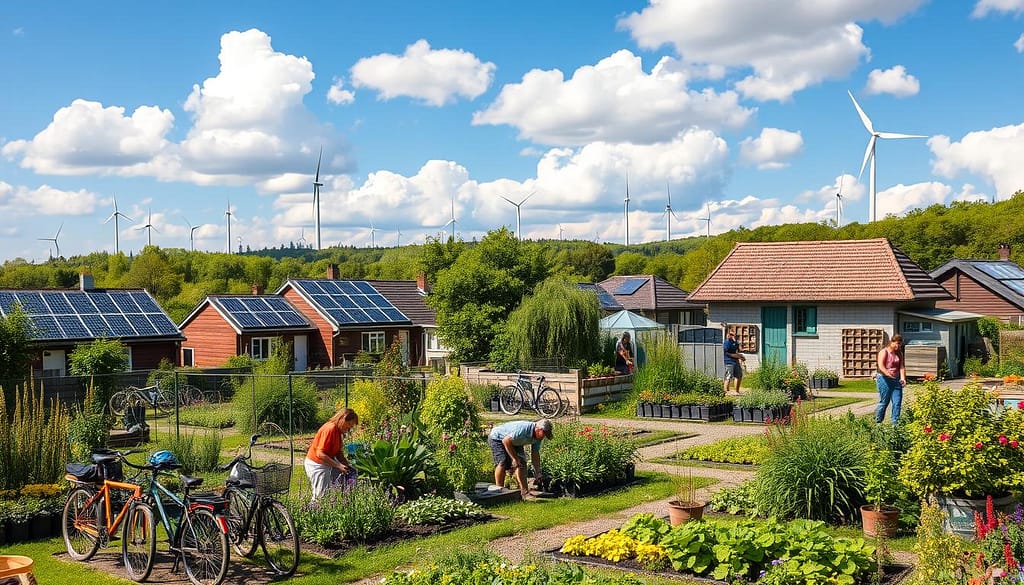50 Inspiring Sustainable Lifestyle Ideas to Embrace Sustainable Living Now
Adopting sustainable lifestyle ideas is crucial now more than ever. Our planet is facing big environmental challenges, and it’s important to live sustainably to protect it. There are many ways to help, from reducing your carbon footprint to making eco-friendly choices.
Here’s a list of 50 ideas to start your journey to a greener life. These actions can help you live more sustainably and make a difference.

Small changes in your daily life can help fight climate change and protect the environment. You can eat more sustainably, use less energy, or support local farmers. Every action you take matters.
Let’s look at how you can add these sustainable ideas to your daily routine. Together, we can make a positive change.
Introduction
In today’s world, living sustainably is essential, not optional. It helps fight climate change and cuts down our carbon footprint. By choosing eco-friendly options every day, we help keep the planet healthy for those who come after us.
First, we must understand the big environmental problems like global warming and carbon emissions. These issues need our urgent and ongoing efforts. Our choices, from what we buy to how we throw away waste, greatly affect our carbon footprint.
Living sustainably isn’t about making huge changes all at once. It’s about making small, steady steps that make a big difference over time. By being aware of how our actions impact the earth, we can make choices that support a greener future.
What is Sustainable Living?
Sustainable living means adopting practices that help the planet. These practices match the United Nations’ sustainable development goals. They aim for environmental protection, social fairness, and economic growth.
Living sustainably means making choices that help the environment. This includes reducing waste, saving energy, and cutting down on carbon emissions. By doing this, you support efforts to solve big environmental problems.

Learning about sustainable living helps you make better choices. It’s about making small but important changes. For example, using reusable items, choosing renewable energy, or adopting green habits at home.
Adding sustainable development goals to your life doesn’t mean big changes right away. Start by looking at your habits and finding ways to improve. Every step you take helps create a better, greener future for all.
Key Sustainability Facts
- Reduce Meat Consumption: Cutting meat can lower food-related carbon emissions by up to 73%.
- Install Renewable Energy: Solar panels can reduce energy bills by up to 50% annually.
- Cut Down on Plastic: 8 million tons of plastic enter oceans each year, harming marine life.
- Energy-Efficient Appliances: Upgrading appliances can reduce energy use by 30%.
- Water Conservation: Fixing leaks can cut household water use by 20-30%.
50 Inspiring Sustainable Lifestyle Ideas
Sustainable Eating
Choosing sustainable eating helps our planet and keeps you healthy. Making smart food choices reduces harm to the environment. It also boosts your well-being.

Eat Less Meat
Reducing meat is a great step towards sustainable eating. You don’t need to be a vegetarian. Just eating less meat can make a big difference. Start by adding more plant-based meals to your diet.
Buy Regional and Seasonal Products
Buying local and seasonal cuts down on carbon emissions. These foods taste better and are more nutritious. Regularly visit farmer’s markets for fresh, seasonal produce.
Reduce Food Waste
Households waste a lot of food. Plan meals and shop with a list to avoid waste. Also, store leftovers well and get creative with them.
Try Meatless Mondays
Meatless Mondays help reduce meat intake and support sustainable eating. Eating meat-free one day a week lowers emissions and saves resources.
Grow Your Own Vegetables
Growing your own veggies ensures fresh produce and appreciation for food effort. Even a small herb garden or container plants can make a difference.
Support Local Farmers
Buying from local farmers benefits your community and supports sustainable farming. You get fresher products and reduce transportation emissions.
Choose Organic Products
Choosing organic is healthier for you and the planet. Organic farming avoids harmful chemicals, uses less energy, and improves soil health.
Compost Food Scraps
Composting turns waste into nutrient-rich soil. It reduces landfill methane and enriches gardens. This completes the food cycle sustainably.
Preserve Food for Longer Shelf Life
Learning to preserve food like canning and freezing reduces waste. It also keeps your favourite seasonal produce available all year.
Use Reusable Grocery Bags
Switching to reusable grocery bags is a simple yet impactful change. It helps reduce single-use plastic waste and protects the environment. These bags are durable, versatile, and can carry more weight than plastic bags.
Sustainable Transportation Ideas
Choosing eco-friendly transportation methods can greatly reduce your carbon footprint. Using bikes or public transportation like buses and trains is good for the environment and can save money. Walking for short trips promotes sustainability and physical health.
Fly Less
Air travel is a big contributor to carbon emissions. Opt for trains or carpool with friends and family when you can. This reduces your environmental impact and makes your journey more relaxed.
Use Bikes or Public Transport
Using bikes or public transport is key to sustainable travel. Public transport reduces personal vehicle use, lowering carbon emissions.
Walk for Short Trips
Walking is a zero-emission way to get around for short trips. It’s also a great way to get some exercise. Plus, it’s often more scenic and enjoyable.
Carpool to Work or School
Carpooling reduces the number of vehicles on the road, cuts down on traffic, and lowers one’s carbon footprint. Setting up a carpool routine can make a big difference.
Invest in an Electric Vehicle
Electric vehicles are becoming more popular because of their eco-friendly benefits. They help reduce greenhouse gases and fossil fuel reliance, making them a sustainable transport solution for the future.
Plan Staycations Instead of Vacations
Staycations are a great way to relax without the environmental costs of travel. They help cut down on carbon emissions and let you discover local gems.
Drive Fuel-Efficient Cars
If an electric vehicle isn’t for you, consider a fuel-efficient car. These cars use less fuel and produce fewer emissions. It’s a practical step towards a more sustainable lifestyle.
Use Trains Over Planes for Travel
Trains are a more sustainable travel option than planes. They produce less CO2 per passenger and offer a comfortable, scenic journey for medium to long distances.
Explore Ride-Sharing Apps
Ride-sharing apps offer a modern way to reduce cars on the road. They help you find carpooling partners, ensuring efficient travel while reducing environmental impact.
Maintain Vehicle for Maximum Efficiency
Keeping your vehicle in top shape is key to living sustainably. Regular maintenance ensures it runs well and is kind to the planet. Tune-ups, proper tire pressure, and oil changes help a lot.
Sustainable Living Around the House
Changing your home to be more sustainable can save a lot of energy. Start by assessing your energy use and making smart upgrades.
Reduce Energy Consumption
Lowering your energy use is a big step. Simple actions like turning off lights and using efficient appliances make a big difference.
Install Energy-Efficient Windows
Getting energy-efficient windows helps keep your home at a good temperature. This means you don’t need to use as much heat or air conditioning.
Unplug Devices When Not in Use
Always unplug devices and chargers when not in use. This small habit can save a lot of energy over time.
Use LED Lighting
Switching to LED lighting is a smart move. LEDs use less power and last longer than old bulbs.
Switch to Renewable Energy Providers
Choosing renewable energy for your home is a smart choice. Going solar is both good for the planet and your wallet.
Install Solar Panels
Putting in solar panels is a great way to use the sun’s power. It reduces the use of fossil fuels and saves money on bills.
Use a Smart Thermostat
A smart thermostat helps control your home’s temperature better. Homes with these devices use less energy.
Line Dry Clothes Instead of Using a Dryer
Try to avoid using the dryer. Line drying clothes saves energy and makes them last longer.
Insulate Your Home Properly
Good insulation keeps your home at a comfortable temperature. This means you use less energy for heating and cooling.
Take Shorter Showers to Conserve Water
Shorter showers save water. Adding water-saving fixtures to your home is also a good idea.
By following these tips, you make your home more sustainable and save money on bills. Start making these changes to live greener and more efficiently.
Sustainable Consumption
Sustainable consumption habits are key to reducing waste and promoting a circular economy. This section offers practical steps for making environmentally friendly choices in daily life.
Buy Less, Repair More
Instead of buying new items, try repairing what you already have. This reduces waste and makes your belongings last longer. You can find repair tutorials online or visit a local repair shop for help.
Choose Sustainable Brands
Choose brands that focus on sustainability in their production. Look for companies that use eco-friendly materials and support ethical labor practices. Brands like Patagonia and Eileen Fisher are known for their sustainable efforts.
Avoid Fast Fashion
Fast fashion harms the environment. Opt for timeless pieces from sustainable brands or shop at second-hand shops. This reduces your impact on the planet.
Buy Second-Hand Clothing
Shopping at second-hand shops is budget-friendly and eco-friendly. It reduces demand for new clothing and keeps items out of landfills.
Borrow or Rent Instead of Buying
Consider borrowing or renting items you rarely use, such as power tools and party supplies. Sharing resources is a great way to practice sustainable consumption.
Use Refillable Water Bottles
Single-use plastics are a big problem. To reduce plastic waste, switch to reusable and refillable bottles. Brands like Hydro Flask and S’well offer stylish, durable options.
Say No to Single-Use Plastics
Single-use plastics, like straws and plastic bags, take hundreds of years to decompose. To minimize your plastic footprint, choose reusable alternatives, such as metal straws and cloth bags.
Opt for Digital Subscriptions Instead of Paper
Choosing digital subscriptions for magazines and newspapers reduces paper waste. This simple switch helps preserve trees and lowers your carbon footprint.
Choose Recyclable Packaging
When buying, select products with recyclable packaging. This reduces waste and supports recycling. Companies like Seventh Generation use eco-friendly packaging for their products.
Use a Reusable Coffee Cup
Bring a reusable cup when getting coffee on the go. Many cafes offer discounts for customers who bring their own cups. It’s a simple way to avoid single-use plastics.
DIY and Home Projects
DIY projects are a great way to live sustainably. They save money and help the planet. Upcycling and making eco-friendly products at home cuts down on waste and saves resources.
How to Upcycle Old Furniture
Upcycling old furniture is fun and rewarding. It gives new life to items that might be thrown away, and by giving them a fresh paint job, new hardware, or fabric, you keep them out of landfills.
It also means using less new materials. This supports a greener lifestyle. Be creative and mix different parts to make something unique. Upcycling lets you show your style while helping the environment.
DIY Eco-Friendly Cleaning Products
Choosing eco-friendly cleaning products is key to reducing waste and harmful chemicals. You can make your own using natural stuff like vinegar, baking soda, and essential oils. These are just as good as store-bought ones but better for the planet.
For example, mix white vinegar and water with lemon essential oil for a cleaner. It’s cheaper and makes your home healthier. Start these DIY projects to live more sustainably.
